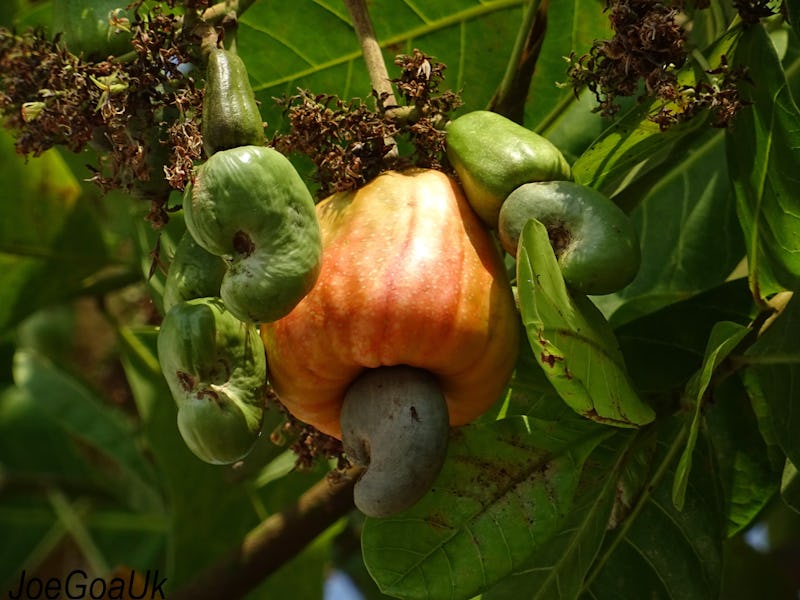Sunscreen Can Be Synthesized From Cashew Shells, but Don't Try This at Home
Cashew-derived chemicals are a new alternative to sunscreens made from petroleum.

A lot goes to waste in the process of cashew farming. Each beloved nut grows beneath a plump yellow or red “apple” and is encased in a hard shell, and everything but the nut often ends up in the trash. New research in the European Journal of Organic Chemistry, however, suggests we divert some of that waste toward beach-goers. Cashew shells, the study shows, contain the starting materials for a very powerful sunscreen.
The research, conducted by “green chemists” from the University of the Witwatersrand in Johannesburg as well as researchers from Germany, Malawi, and Tanzania (where cashews are a huge export), shows that cashew shells can be used to synthesize powerful UV-absorbing compounds.
The seed at the bottom of the cashew "apple" is the nut, encased in a chemical-rich shell.
The news comes at a good time, because conventional sunscreens are becoming increasingly controversial. Some of the UV-blocking chemicals they commonly use appear to threaten marine organisms, like coral and the animals living within it, when they wash off into the sea, and furthermore, they don’t biodegrade easily. One of those common compounds is oxybenzone, which is not only harmful to marine life but also derived from petroleum.
The compounds that can be synthesized from “cashew nut shell liquid,” the team suggests, not only absorb UV radiation but also are derived from organic waste instead of fossil fuels.
How UV Chemicals in Sunscreen Work
Sunscreen’s active ingredients are often compounds that can absorb, reflect, and scatter high-energy UV light, which can cause harmful damage to DNA and cause burns. The molecular structure of these compounds gives them the ability to absorb those high-energy UVA and UVB rays before they hit the skin, re-releasing them as lower-energy rays.
The cashews we are used to seeing are encased in a hard shell, which can be used to make sunscreen compounds.
A compound’s sun-screening ability is measured by the region of the electromagnetic spectrum where it absorbs light. Most UV filters, the team writes, have high absorption in the region from 315–400 nm (that’s UVA light) and 280–315 nm (UVB light). The commercial sunscreen oxybenzone, together with 2-ethylhexyl 4-methoxycinnamate (OMC) and avobenzone, do well in this region.
Same goes, the team writes, for the compounds that can be derived from cashew shells.
To be a useful sunscreen, a compound needs to be able to absorb light in the high-energy ultraviolet zone of the electromagnetic spectrum.
Starting with the cashew nut shell liquid, which contained the important starting chemicals anacardic acid, cardol, and cardanol, the team got to work synthesizing new compounds. These three starter compounds all belong to a molecular family known as the phenols, which means their shared chemical structure makes them particularly good at absorbing UV light (oxybenzone has a similar structure).
Among many chemicals that the team created, they say four (some benzophenones and s-triazine) meet the requirements for future development because they’re good at absorbing both “broad-spectrum” UVA and UVB light. They may also be “emulsion-stabilizing,” which means they may be particularly easy to mix into a sunscreen, to boot.
Don’t Try This at Home
Some traditional sunscreen compounds are increasingly controversial because of their harmful effect on marine life.
This discovery is promising because it’s green: Using cashew nut shells as a starting material for sunscreens means repurposing materials otherwise bound for the trash, which is already far more sustainable than relying on petroleum dredged from the Earth.
The question now is whether the compounds are toxic to humans and aquatic life — and just as importantly, whether the chemical process that makes them is actually as green as the green chemists’ ethos.
There’s a lot of room for innovation in the sunscreen space these days, as the chemicals we’ve relied on for years don’t seem to be as benign as we always thought. In addition to the concerns about oxybenzone in the environment, this week, scientists showed in Environmental Science and Technology that some metals and inorganic compounds in sunscreen, like titanium dioxide and aluminum, also harm marine life when they dissipate into the sea. Furthermore, recent research from the FDA has raised concerns that some compounds from conventional sunscreen can enter the bloodstream when used at very high concentrations.
Unfortunately, these concerns have led some people to stop using sunscreen or to try making their own DIY sunscreen at home. For now, sunscreen is still the safest way to protect ourselves from the sun’s harmful UV rays (other than staying in the shade) and is an important part of preventing skin cancer.
We don’t have great alternatives, but until scientists figure it out, trying to make your own is probably not the best call: As the chemists behind this paper showed, there’s a lot of technical chemistry involved in choosing a chemical that absorbs UV light in a useful way, even if its starting materials are ones we’re all familiar with.